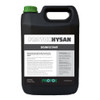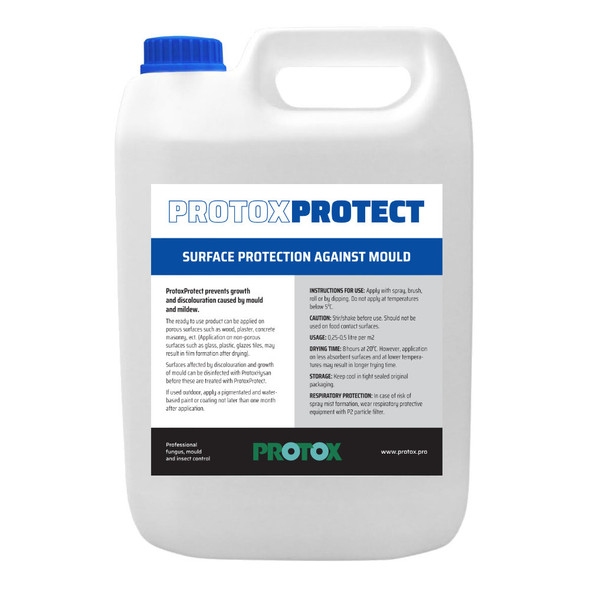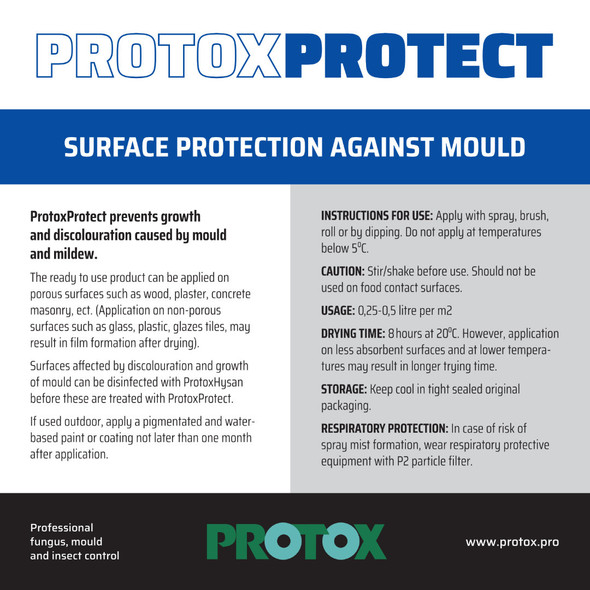* Prices subject to availability. There is a 12 week lead time on 1/2 pallet and full pallet orders, as well as a 15 month expiry guarantee once arrived in the country
Protox Hysan is a product specifically developed for the cleaning and disinfection of mould. In addition, it can be used for a variety of other purposes such as odour removal and disinfection after bacterial growth and viruses.
Protox Hysan can be used as a traditional detergent.
- Developed for the cleaning and disinfection of mould
- Can also be used for odour removal and disinfection after bacterial growth and viruses
- Environmental safety is a key advantage of chlorine dioxide when comparing with alternative biocides such as chlorine
- Square meter price is depending on the dilution
Odour Elimination
Foul odours from mould growth, bacterial growth, animal carcasses, human remains, soot or fire damage etc. can be removed by soaking/washing the affected surface with ProtoxHysan. May be combined with a ProtoxAbScent bag which should be suspended to eliminate any remaining odours.
Mould Prevention
It is important to eliminate the courses of the mould contamination. If the causes are not eliminated the mould will probably reoccur.
If you cannot remove the cause, you can prevent new mould attacks using Protox Mould Protector. Apply the substance to the cleaned surface with a brush, spray or similar, after which the surface should be re-papered, painted or otherwise completed. Protox Mould Protector has been tested for degassing and can be safely used indoors
Durability: Protox Hysan is durable upto approximately 1 & 1/2 (1.5) years in unopened packaging. Store frost-free.
Dilution of Hysan and Costing
Application 500ml mixed per Square Meter
Ratio
The square meter price is depending on the dilution and the attack of extreme mould use neat to 1:1, Little attack of mould use 1:2 to 1:3.
Mould
If discoloration and growth of mould have occurred, wash the affected surface with Protox Hysan. Optionally combine it with mechanical cleaning.
If there is a risk of reclamation of the cleaned area, it is advisable to prevent new mould growth with Protox Mould Protect.
Odour Removal
Poor odour can be removed by soaking or washing the affected surfaces.
Bacterial and viral disinfection
Protox Hysan is an effective disinfectant against all forms of bacteria and viruses. Examples of using Protox Hysan are therefore many. For example. after cloud breaks with ascending E. Coli infected sewage, disinfection after dead animals and people, post-ectopic disinfection, Legionella, Listeria, avian influenza virus, Newcastle virus, etc.
Indoor
Protox Hysan leaves no harmful chemical residues on the treated surfaces. There is hence no limitation on the size of the treated area.
Fog Spraying
In the event of a foul odour fog spray, Protox Hysan will have a large disinfectant effect on airborne particles such as bacteria and viruses. Note remove all contents.
Chlorine Dioxide Gas
In the event of an extream odour mix with Protox Activator to make Free Chlorine Dioxide Gas
CHLORINE DIOXIDE
The ingredients in Hysan is Chlorine Dioxide and tab-water.
But chlorine dioxide is very different from chlorine in its chemistry.
While chorine dioxide has chlorine in its name, its chemistry is radically different from that of chlorine. It has to do with the way electrons interact with one another. We should not be misled by the fact that chlorine and chlorine dioxide share a word in common. The chemistries of the two compounds are completely different.
Chlorine dioxide and chlorine – because of their fundamentally different chemistries – react in distinct ways with organic compounds, and as a result generate very different by-products. It's this difference that explains the superior environmental performance of chlorine dioxide in a number of industrial applications.
In water treatment applications, chlorine dioxide, because of its more powerful action, has broad spectrum activity over a wide range of micro-organisms, and has the ability to penetrate biofilms, and other heavily contaminated areas, where chlorine treatment is simply not effective. Because of its increased efficiency, far less of the chlorine dioxide product need be used, eliminating waste, and reducing handling costs and risk.
Environmental safety is a key advantage of chlorine dioxide when comparing with alternative biocides such as chlorine.Chlorine Dioxide is becoming an increasingly popular choice for biocidal applications in industries around the world.
Unlike chlorine, ClO2 will react to form mainly inorganic disinfection by products, the predominant species being chlorite. Chlorite will subsequently reduce to form harmless chloride. The speed of this reaction depends upon a number of factors, however within saltwater conditions this can be as low as 5 minutes. Although lower chemical costs and better generation equipment have increased its market profile significantly over recent years, the core chemistry is well established and far from new. Here we cover what is ClO2, key facts about the chemical, and its development and use over time as a powerful disinfectant.
ClO2 Factfile
What is Chlorine Dioxide?
Chlorine Dioxide is a small, volatile and very strong molecule consisting of 1 Chlorine atom and 2 oxygen atoms. Abbreviated to ClO2, Chlorine Dioxide exists as a free radical in dilute solutions
- Molecular weight of 67.45.
- It is a gas at normal temperatures and pressures.
- Melting point of -59oC.
- Boiling point of 11oC.
- Yellowish/green colour and has an odour similar to that of Chlorine.
- Denser than air and is water soluble at standard temperatures and pressures up to 2500ppm.
- Explosive in air at concentrations >10%. It is therefore normally generated in-situ within an aqueous solution at <0.2%
- Some pre-mixed solutions are sold on the market at concentrations of 0.6%, however these are hazardous to transport and costly. Most ClO2 is applied using on site dosing and generation equipment from companies like Scotmas.
- It will decompose in the presence of UV, high temperatures >70oC, and high alkalinity (>pH12).
ClO2 Timeline
- 1811 first discovered by Sir Humphrey Davey
- 1944 First commercial application. Used as a biocide/taste and odour control agent in domestic water at Niagara Falls in the USA.
- 1977 Three thousand municipal water systems achieving biological control using Chlorine Dioxide.
- 1980’s Chlorine Dioxide gradually replacing Chlorine in many industries.
- Pulp and Paper industry - used as a bleaching agent.
- Industrial water treatment - used as a biocide and as an odour control agent.
- Food processing - used as a sanitiser.
- 1990’s Increasingly used for the secondary disinfection of potable water.
- 2005 – New generation equipment and control technology introduces ClO2 as a practical alternative to many industrial applications.
Hysan is a broad spectrum bactericidal, virucidal, fungicidal and sporicidal hard surface disinfectant manufactured by Scotmas that harnesses the power of Chlorine Dioxide to deliver a broad spectrum biocidal kill in accordance with the requirements of EN13697.
Applied as a surface spray or fog, or impregnated to gel and wipe formulations, the unique dual action chemistry of Hysan provides total peace of mind.
Indoor climate
With Protox Hysan no harmful chemical residues are left in the building. Turns to table salt and water after oxidizing after 24 hours.
Residual effects
Protox Hysan leaves no harmful residual reducing to water and the equivalent of table salt. The salt concentration is so low that testing has shown no adverse effect on metals and in the Protox lab metal has been left in undiluted Hysan for several days without any corrosion seen.
Preparation
Mould can usually be recognised by the presence of black-brown, blue-green and whitish stains and spots on theaffected building part. Mould often sits on the inner side of wallpaper but it can also occur behind wallpaper and even behind plaster on, for example, brick, concrete etc. If there is mould behind the wallpaper on plaster, you must REMOVE the wallpaper or plaster BEFORE you begin treating the mould.
Tools
- Pump Up Sprayer (recomend our Gloria Sprayers )
- Protective gloves, Tyvac suit for heavy mould
- Brush - semi-stiff nylon dish-washing brush or motorized hand scrubber
- Protective drop sheet if necessary
- Micro Fiber Cloth to mop up spills
- If necessary eg Mould Present use Clean Space respiratory protection (P3)
How should I dilute Protox Hysan?
Protox Hysan is a concentrate that can be diluted as required. Concentrated Protox Hysan - for particularly stubborn discoloration and odour elimination.
- 1 part Protox Hysan + 1 part water - for severe cases
- 1 part Protox Hysan + 2 parts water - for moderate
- 1 part Protox Hysan + 3 parts water - for rinsing or condition 2 Mould (surface light mould)
Cleaning Mould with Protox Hysan
- Vacuum the surface thoroughly with a HEPA filter attached to the vacuum cleaner.
- Mix a solution of Protox Hysan and water in a pump up sprayer. Gloria Sprayers a Gloria Foamer or a window cleaning applicator (usually made of micro fibre) for gyprock walls that are condition 2 mould.
- Spray the Protox Hysan solution on the affected surface and then agitate with a motorized made for walls scrubber, hand brush, light agitation with a soft broom or sponge scrub thoroughly until the mould has been loosened from the surface. Consumption (how much product used): approx. 1/2 litre per m2.
- Rinse the treated surface until clean with the remaining Protox Hysan solution using a pump up sprayer (we recommend our Gloria Sprayers) or a window cleaning applicator (usually made of micro fibre) for gyprock walls that are condition 2 mould. In this way, you will remove the greatest amount of spores, particles and dirt from the surface.
- Allow 24 Hours to oxidize then if there is a stain present apply Protox HP 18 with Protox Turbo for mould stain removal.(note only mix what you need follow PPE guidelines on SDS and the product mixed will only last for 5 hours so disposed what you don’t need (the toilet is the best place). Protox Encapsulator can be applied to areas that you cannot clean (being hard to access) with a Gloria Sprayer or brush or roller. Protox Protect can be applied to protect area from mould growth especially if the problem hasn't been fixed.
- After 24 hours, the surface may be wiped with pure water.
- Hysan can also be spread using a fogger if you need to eliminate odours from a difficult to access space.


















